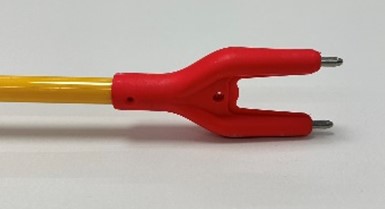Genetics Selection Evolution: genomic selection improves resistance to hoof disease

Approximately one in three dairy cows in the UK suffers from lameness. Reducing the prevalence of this disease is a key priority for the country's dairy industry .
Scientists from a number of UK universities conducted a genome-wide association search (GWAS) for a group of hoof diseases in Holsteins - hoof horn lesions (CHL), including sole hemorrhage (SH), sole ulcer (SU) and white line disease (WL ) . Quantitative trait candidate loci (QTLs) were identified on the BTA3 and BTA18 chromosomes for all traits under consideration.
Hoof horn lesions are complex traits with a polygenic type of inheritance. The heritability estimates for susceptibility to SH and SU (the likelihood that the animal will get sick) were 0.29 and 0.35, respectively. Estimates of heritability of severity (how severe the lesion would be if the animal got sick) were 0.12 and 0.07, respectively.
it turned out that the genetic correlation between SH and SU is high - 0.98 for the predisposition to the lesion and 0.59 for the severity of the lesion. The heritability of WL was found to be comparatively lower, meaning that the environment has a stronger influence on the development of white line disease than the other two diseases. However, the genetic correlations of SH and SU with WL were also positive.
In addition, CHL-associated candidate genomic regions have been found to contain annotated genes that are associated with immune system function and inflammatory responses, lipid metabolism, calcium ion activity, and neuronal excitability.
The scientists conclude that the incidence of lesions of the hoof horn is moderately heritable, and resistance to them can be increased using genomic selection. It should be noted that under different conditions, animals will show resistance in different ways, so it can be increased only on local assessments and when fixing disease phenotypes in their own enterprise.
Read together with it:
- С января по июль экспорт свинины из ЕС вырос на 1,6%На втором месте оказались Нидерланды с объёмом экспорта в 392 000 тонн. Дания экспортировала свинину в третьи страны с объёмом в 308 000 тонн, что примерно на 13% меньше, чем в предыдущем году. Германия экспортировала 180 000 тонн, что на 18% меньше, чем годом ранее. Это было обусловлено, главным образом, дополнительными ограничениями на экспорт, вызванными вспышкой ящура в начале года. Помимо зап...
- Матричные РНК-вакцины от COVID продлили жизнь тяжелых раковых больныхМатричные РНК-вакцины против коронавируса продлили жизнь пациентам, больным раком в самой тяжелой, четвертой стадии, сообщает The Washington Post. К такому выводу пришли исследователи Онкологического центра имени М. Д. Андерсона Техасского университета и Университета Флориды. «Эти данные невероятно интересны, но они должны быть подтверждены в ходе третьего этапа клинических испытаний», — заявил од...
- How Trump moved to tough sanctions and abandoned a summit with PutinDonald Trump has changed his mind about meeting with Vladimir Putin in Budapest, and the US Treasury has imposed sanctions on two of Russia's largest oil companies. RBC investigated why the US president changed his position and what NATO is offering him. How Trump has changed his rhetoric toward RUSSIA.On the night of October 23, US President Donald Trump announced that he had cancelled a meeting ...
- The EU has responded to Putin's plans to visit Hungary amid sanctions.EU sanctions against Putin and Lavrov only include asset freezes and do not impose entry bans , an EC spokesperson stated. The Foreign Ministry emphasized that they have no assets abroad. Vladimir Putin The EU sanctions against Russian President Vladimir Putin do not include a travel ban to the EU, European Commission spokesperson Anitta Hipper stated, commenting on a possible meeting between the ...
- Chinese scientists have discovered a new natural meat preservative.In an experiment, cinnamon oil effectively inhibited the growth of Shewanella putrefaciens, a microorganism responsible for the decay of protein products even at low storage temperatures. Even at minimal concentrations, the oil inhibited bacterial growth, damaged their internal and external membranes, disrupted cell integrity, and caused protein and nucleic acid leakage. Additionally, the essentia...
- The UK has imposed blocking sanctions against Lukoil and Rosneft.LUKOIL and Rosneft have been added to the sanctions list on the UK government's website. Measures have also been imposed on a number of banks and the National Payment Card System.The UK has imposed sanctions against LUKOIL and Rosneft. This information is published in the sanctions list on the UK government website. The measures include asset freezes, as well as sanctions on trust services and tra...
- Russia is developing a new swine flu vaccine based on two strains.The vaccine is being developed using two strains: pandemic H1N1 and classical H3N2, isolated in the Kursk region and Udmurtia. According to Dmitry Biryuchenkov, HEAD of the swine disease prevention laboratory at the All-Russian Research Institute of Animal HEALTH, the vaccine has already demonstrated high efficacy and safety for pregnant sows and piglets. Development is expected to be completed in...
- About shashlik, point of view, and dragons. An interview with Academician D.A. Baimukanov.PIONERPRODUKT.by continues its series of interviews with the eminent Kazakhstani scientist Dastanbek Asylbekovich Baimukanov , recorded by his younger brother, Syzdyk Asylbekovich Baimukanov. The first interview is titled: "A Story of Shepherds, Sheep, and Freedom . " The second interview is titled: " On Beshbarmak, Money, MEAT, Traditions, Genetics, and Selective Breeding." We remind you that num...
- A large livestock complex has opened in Parokhonsky, Pinsk District.October 9, Brest. A large livestock complex opened on October 9 on the territory of Parokhonskoye JSC in the Pinsk District , BelTA reports. Construction in the village of Kamen began in November 2024. Workers completed the project this September. The farm used its own funds and also secured a loan. Parokhonskoye is focusing on MILK and MEAT production. Facilities are being reconstructed to increa...





























































